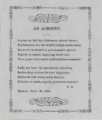Acrostic facts for kids
An acrostic is a special kind of poem or writing. In an acrostic, the first letter, syllable, or even a whole word from each line spells out a hidden message, a name, or another word. It's like a secret code woven into the text! People often use acrostics to help them remember things, or just for fun.
Contents
How Acrostics Work
The most common type of acrostic uses the first letter of each line. For example, if you wanted to write an acrostic for the name "ANNA," your poem might look like this:
- Always kind and true,
- Never sad or blue,
- Nice to everyone,
- All day long, having fun.
Here, the first letters (A, N, N, A) spell out the name. Acrostics can be simple or very complex.
Famous Acrostics
Many writers throughout history have used acrostics. A famous example in English was written by Edgar Allan Poe. He wrote a poem where the first letter of each line spells out the name "ELIZABETH":
Elizabeth it is in vain you say
"Love not" — thou sayest it in so sweet a way:
In vain those words from thee or L.E.L.
Zantippe's talents had enforced so well:
Ah! if that language from thy heart arise,
Breath it less gently forth — and veil thine eyes.
Endymion, recollect, when Luna tried
To cure his love — was cured of all beside —
His follie — pride — and passion — for he died.
As you can see, the first letters of each line clearly spell out Elizabeth. This shows how acrostics can be used to dedicate a poem to someone or to hide a special meaning.
Different Types of Acrostics
While the most common acrostics use the first letter, there are other types:
- Mesostich: This is when the hidden word or message appears in the middle of each line.
- Telestich: In this type, the hidden message is spelled out by the last letter of each line.
- Double Acrostic: Some acrostics are even more clever, with messages hidden at both the beginning and the end of each line.
Why Are Acrostics Used?
Acrostics have been used for many reasons over time:
- Memory Aids: They can help people remember lists or facts. For example, you might use an acrostic to remember the order of planets.
- Dedication: Writers sometimes use them to dedicate a work to a specific person without stating their name directly.
- Fun and Games: Acrostics are also a popular form of word puzzle and creative writing exercise. They challenge writers to be creative within a set structure.
- Secret Messages: Historically, acrostics have been used to hide messages, especially in times when direct communication was risky.
Images for kids
-
An 1850 acrostic by Nathaniel Dearborn, the first letter of each line spelling the name "JENNY LIND"
See also
 In Spanish: Acróstico para niños
In Spanish: Acróstico para niños


